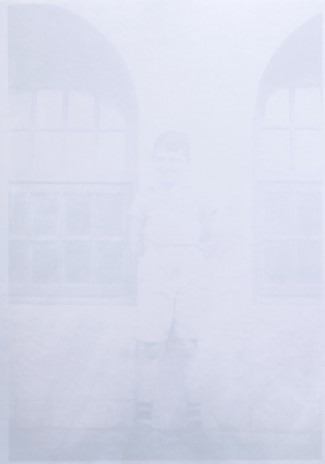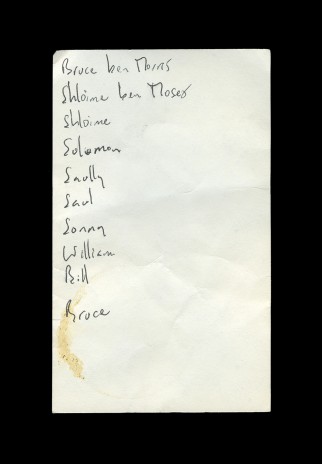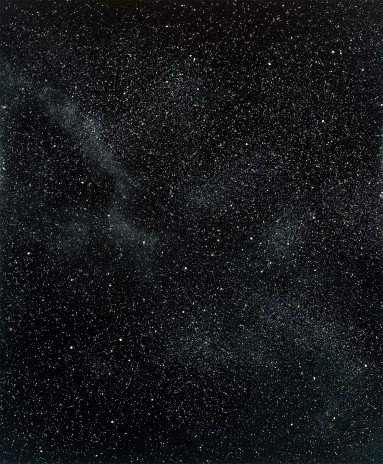David Miller uses photography to record the vital processes things go through, the palpable reality in them that fades and the dark zone that grows in them instead. The question of memory, which wavers as its visual and material correlates disappear, arises.
With his poetic, paradoxical and also philosophical use of photography, Miller accompanies images until they disappear completely, which also entails questioning the duration and durability of representations. In each image or dark paper (depending on the moment one approaches the item) the opposing pairs of reality/representation in fact collapse. What meaning do the representation and its medium (the photograph as an object and an artwork) have when the image disappears? Is it meaningful to refer to the originating, if not original, object/person (of the image)? Memory, as one of many possible worlds or realities, seems to put down roots in a great darkness.
Sol’s light — or the luminous soul of darkness
Sol’s Light is a photographic show, a working space for experimenting with light and time in photography, an archive of both objective and subjective phenomena. Within the framework of the Fotograf Festival #4, titled “Seeing Is Believing”, David Miller performs a powerful act of documentation and homage.
A very enigmatic portrait of his father, alive, and another, even more enigmatic, of his father dead. The enigma of the first one lies in the unusual position of the man, sitting with his back to the viewer; he is reflected in a mirror, yet the expression on his face cannot be seen. The enigma of the second one lies in the fact that the earth on Sol’s tomb takes on the appearance of a starry night sky, in his son’s photographic portrait.
A third enigma surfaces in a list of names – the various names the father used throughout his life and which David Miller records in his own handwriting. Sol is not in the list, as it is being used only by her son (or sun?), and only after his death. This domestic document constitutes another way of representing Sol, of brushing against his brilliance.
No, the idea is not to decipher who Sol was. David Miller is not proposing a quintessential quest; he is presenting his own vision, a few shadows and the clear limits of interpretation. Sol is shown while alive; he is named, something of his death is shown and then he is named once again by means of a book: Arthur Miller’s Death of a Salesman. This trace of Sol is a doubly blurry image for the viewer, because only the author knows that the reference is to a book and only he, the son, knows that the book reminds him of his father. All we can see is a greyish rectangle.
Lastly, there is a stack of more traditional portraits in which we see Sol’s face at last represented in contact prints that emulate late 19th century methods. The first image in the stack, the most consummate one, disappears gradually over time due to constant exposure to light. And the last one, at the bottom, has barely anything printed on it at all, except for something of a dark border where a bit of light has managed to seep in. The father’s presence becomes increasingly subtle, increasingly subjective. At the end (of his life), it depends entirely on the son’s memory.
Time in photography is not an idea or a metaphor, but a very concrete resource. A direct contact print and photographic images generally depend on the amount of time they are exposed to light. By applying an eraser to a stack of photographic paper, a different image is produced on each sheet in the stack. If one moves the eraser during the period of light exposure, new images, shadows or ghosts are produced. The same can be done with countless objects, exposure times, fixing (or non-fixing) processes, etc. And that is what makes up the second part of David Miller’s showcase.
In Miller’s homage to his father, death is counterpointed with a series of very ‘living’ works comprising series of images that are in continuous transformation because they are obtained by contact and exposure to light. They have not been subjected to any chemical processing. The images are not fixed and then they are not framed – another of the many ways of fixing something. At most, they are washed with water or submerged in salted water so as to slow down the process of total darkening. They are less solemn; they constitute a sort of game in which it is possible to participate, to touch, to move, to reorganize, to conceal and to reveal … Perhaps these are the images that indicate David Miller’s presence – a living and therefore changing presence, relatively foreseeable and yet fortuitous and surprising as well.
In his poetic, paradoxical and philosophical use of photography, David Miller accompanies images until they disappear completely. At each moment in the showcase, misunderstandings and clichés about reality and representation are demolished. What does an image that we know was there but cannot be seen represent? And what about those images we don’t even know they existed because all we see is a dark sheet of paper?
Sol’s Light is an installation in progress. Each day the exhibition will differ, depending on the movement of light and the objects on the paper throughout the day. It will be finished when the period of exposure to both light and the public is over. Thus the last day of the exhibition will also be the last day during which the larger artwork is produced. And, based on his decision to intervene minimally in the process, Miller accepts the partial or total disappearance of the images as the final product of this show. His artwork will be signified by darkness, though we will know that before these shadows brought on by light, everything was filled with images.
— Clio E. Bugel
David Miller is a Canadian artist born in Montreal. He studied media and experimental cinema at Sheridan College, art and art history at the Nova Scotia College of Art and Design (BFA); art and the public sphere at Simon Fraser University’s Institute for Contemporary Art, and completed his graduate research at the Emily Carr University of Art + Design (MAA). Currently, he lives and works in Lethbridge, Alberta, Canada.
His work explores the unrepresentable, presence and absence, the relationship that the technical image establishes between what is evident (appearance) and the unrecoverable (disappearance). The artists’ practice is a persistent enquiry into the nature and act of photography itself.
Notable exhibitions include Das Spydermann at L.A.C.E., Los Angeles; Small World, at Stadtmuseum, Münster, Germany; Execution at W139, Amsterdam, Netherlands; Markado at Centro de la Imagen in Mexico; Collecting Shadows, PlugIn ICA, Winnipeg.
Miller is the 2014 winner of the Duke and Duchess of York Prize in Photography, an annual prize awarded by the Canada Council for the Arts that acknowledges excellence and outstanding achievement in photographic arts.
The artist wishes to acknowledge the support of the Alberta Foundation for the Arts and the generosity of FOMA, manufacturer of traditional photographic materials.


